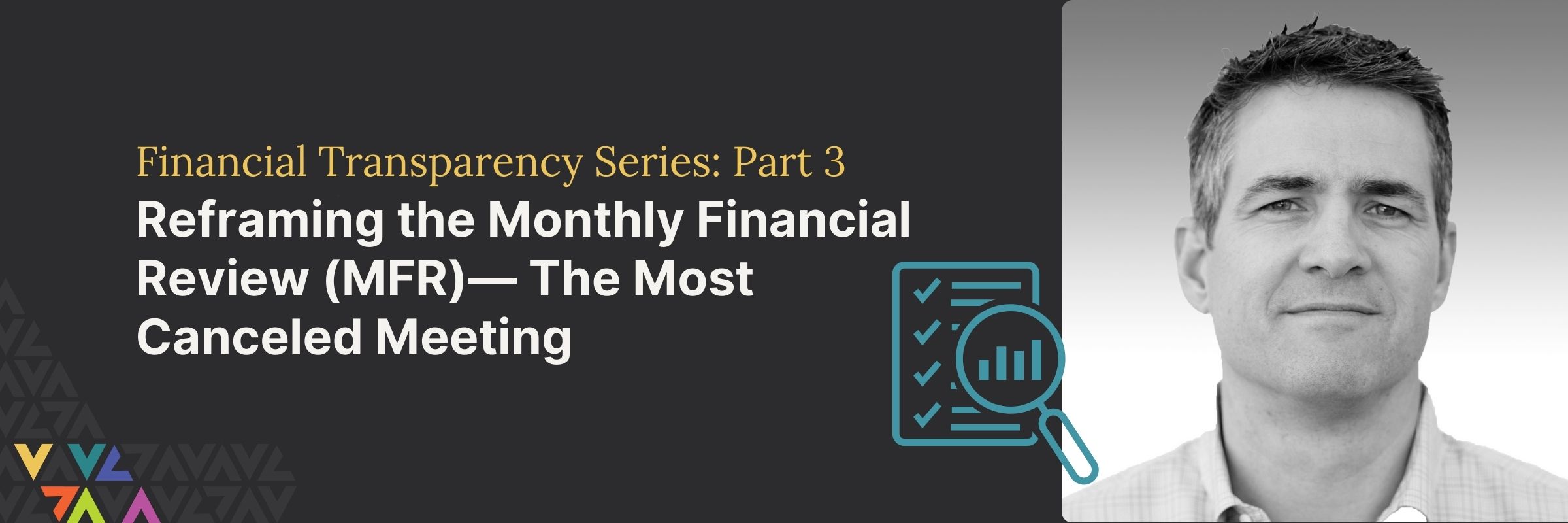
There are simple but powerful ways increasing transparency with your teams around finances can have a positive impact on your business. Here we speak to the MFR meeting which is probably one of the most canceled meetings of early-stage and emerging growth companies. Yet, the leadership teams that we work with recognize and admit that this meeting should be critical to their monthly cadence.
So, if it is agreed to be critical… and it’s the most canceled, pushed, or ignored meeting, then what is the real gap?
There are three leading causes.
1. It’s late.
2. The meeting has the wrong agenda.
3. The team is not asking the right questions.
For this article, we are not going to focus on “It’s Late.” Creating strong systems and processes to close the books on time so that the information in the meeting is current is a topic for another article. Here we’ll focus on ways to address causes one and two through reframing.
Reframing the MFR Meeting
Most commonly, we find that existing MFR meetings focus too much time/energy on reviewing (in detail) and defending the accuracy of the presented financial information. The team confirms what has transpired (in the past). There’s discussion on how things are measured and reported. And the overarching conclusion of the MFR is “we agree on where we are today.”
The MFR sorely needs a reframe to focus on what the actual results mean for the near-term forecast of the company. The meeting should allow the team to reframe around an entirely new set of agreements to create a more thorough leadership team alignment.
Four steps that can transform your MFRs
Step 1 – Are we seeing any new trends emerging?
In the review of the financials, the controller/CFO should highlight for the leadership team (LT) possible new trends that are emerging. This could include shrinking pipeline, shifting conversion rates, supplier cost changes, increased shipping costs, higher payroll/benefits costs, increased marketing spending, and shifts in customer support volumes, to name a few.
Step 2 – New trend root cause alignment/agreement.
Does the LT agree with the trend? Is it part of a longer-term shift or is it short-term in nature? Does the LT agree on the root cause of the trend? Is the LT aligned?
Step 3 – Does the trend warrant change to the “Re-Forecast” model?
Should core assumptions in the re-forecast model be changed to reflect the trends we are identifying in the business? Create LT alignment/agreement on what trends require assumption updates. Create LT alignment/agreement on the new assumptions/drivers in the model.
SIDE NOTE: Often, the CFO can take a preliminary stab at this before the MFR and present to the LT a “CFO Version” of the reforecast based on their experience. The CFO can also make real-time adjustments during the MFR based on LT input. Often, the CFO may need additional time after the MFR to make adjustments and ensure quality in the re-forecast.
Step 4 – Review the Re-Forecast model as a whole… Does it shift key priorities?
Suppose there are a handful of negative trends happening. After updating, the Re-forecast model may show a shift away from growth to cash preservation (as a broad example). And this may impact some key near-term priorities.
How you’ll know if you’ve had a successful MFR
GOAL #1 – Get the LT to agree/align on the new re-forecast model. Before ending the meeting ask the important question, DO WE AGREE?
GOAL #2 – Get the LT to agree/align on any new or shifted priorities and document these. And get clear alignment as to “what this means from a business perspective” overall!
Summary
Shifting the MFR in two major ways can have an enormous impact. First, the MFR meeting should be focused on the look-forward rather than a focus on what’s happened (rear view mirror). Obviously, a strong re-forecast model is a prerequisite! Second, the MFR meeting is about creating LT alignment by getting the LT to be the owners of the re-forecast in totality. While the CFO is the owner of the model itself, the LT must collectively own the business story of the model. Reframing the MFR increases the value and power that this meeting can deliver, and can be a huge step toward realizing the benefits of financial transparency.




